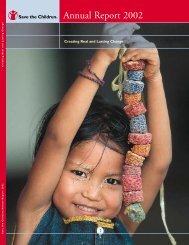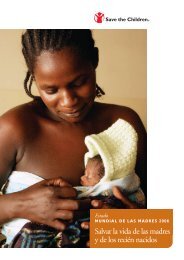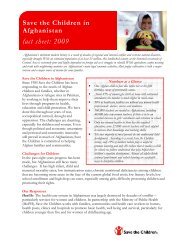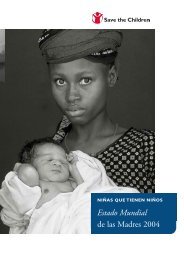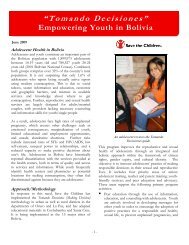Adolescent Sexual and Reproductive Health Toolkit for - UNFPA
Adolescent Sexual and Reproductive Health Toolkit for - UNFPA
Adolescent Sexual and Reproductive Health Toolkit for - UNFPA
You also want an ePaper? Increase the reach of your titles
YUMPU automatically turns print PDFs into web optimized ePapers that Google loves.
• The right to be free from all <strong>for</strong>ms of physical <strong>and</strong><br />
mental abuse <strong>and</strong> all <strong>for</strong>ms of sexual exploitation,<br />
Including sexual violence, domestic violence <strong>and</strong><br />
sexual exploitation.<br />
• The right to equality <strong>and</strong> non-discrimination,<br />
Including the right to access RH services, regardless<br />
of age or marital status <strong>and</strong> without consent of parent,<br />
guardian or spouse.<br />
• All actions taken should be in the best interest<br />
of the child. For example, requiring parental consent<br />
<strong>for</strong> contraception or obstetric care, or refusing services<br />
because of age would not be in the best interest of<br />
the adolescent.<br />
Under international humanitarian law <strong>and</strong> international<br />
human rights law, children are protected from<br />
recruitment <strong>and</strong> use by armed <strong>for</strong>ces <strong>and</strong> groups. The<br />
recruitment <strong>and</strong> use of children under 15 in armed<br />
<strong>for</strong>ces <strong>and</strong> groups are war crimes. In addition to the<br />
UN Convention on the Rights of the Child, international<br />
<strong>and</strong> regional instruments including the Optional<br />
Protocol to the Geneva Conventions <strong>and</strong> the<br />
Additional Protocols, the Rome Statue establishing<br />
the International Criminal Court, <strong>and</strong> the African<br />
Charter on the Rights <strong>and</strong> Welfare of the Child, offer<br />
a legal framework <strong>for</strong> the protection of children.<br />
Although most adolescents (those between 10 <strong>and</strong><br />
18 years of age) are considered to be children under<br />
international law, the evolving capacity of the child is<br />
also recognized. 9 Simply stated, as children progress<br />
through adolescence <strong>and</strong> gain life experiences, they<br />
become more capable of taking important decisions<br />
independently. This is very important when considering<br />
issues related to ASRH, particularly in relation<br />
to providing ASRH services without requiring the<br />
consent of a parent or spouse.<br />
The issue of whether adolescents themselves can<br />
provide in<strong>for</strong>med consent <strong>for</strong> SRH interventions such<br />
as counseling <strong>and</strong> testing <strong>for</strong> HIV, clinical care after<br />
sexual assault, treatment of STIs <strong>and</strong> maternity care<br />
can be sensitive. In 2003, the UN Committee on the<br />
Rights of the Child issued General Comment No. 4,<br />
which describes adolescents’ rights to health <strong>and</strong><br />
development in the framework of the Convention on the<br />
Rights of the Child (UN Committee on the Rights of the<br />
Child, 2003). The comment provides adolescents with<br />
the right to in<strong>for</strong>mation related to SRH, “regardless<br />
of their marital status <strong>and</strong> whether their parents or<br />
guardians consent” (paragraph 28). It also states that<br />
if parents or guardians provide in<strong>for</strong>med consent, the<br />
adolescent should be allowed to express his/her<br />
views <strong>and</strong> those views should be given weight. It<br />
recognizes the evolving capacity of the child by giving<br />
adolescents who are “of sufficient maturity” the right<br />
to provide in<strong>for</strong>med consent “<strong>for</strong> her/himself, while<br />
in<strong>for</strong>ming the parents if that is in the ‘best interest of<br />
the child’” (paragraph 32). <strong>Health</strong> providers have<br />
the obligation to provide adolescents with private<br />
<strong>and</strong> confidential advice so that they are able to make<br />
in<strong>for</strong>med decisions about treatment (paragraph 33).<br />
Finally, adolescents with disabilities are protected<br />
under the UN Convention on the Rights of Persons<br />
with Disabilities. Ten percent of the world population<br />
lives with disabilities <strong>and</strong> 80% of people with disabilities<br />
live in developing countries (<strong>UNFPA</strong>, 2007).<br />
During emergencies, the number of adolescents with<br />
disabilities may increase due to physical or psychological<br />
injury or mental health conditions that<br />
manifest as a result of crisis.<br />
<strong>Adolescent</strong>s with disabilities include those<br />
who have long-term physical, mental, intellectual<br />
or sensory impairments, which in<br />
interaction with various barriers, may hinder<br />
their full <strong>and</strong> effective participation in society<br />
on an equal basis with others<br />
UN Convention on the Rights of Persons<br />
with Disabilities<br />
The disabled are as sexually active as people without<br />
disabilities, but they are three times more likely to<br />
experience sexual violence, putting them at increased<br />
risk of unwanted pregnancy, STIs <strong>and</strong> HIV. People<br />
with disabilities have less access to health (including<br />
mental health <strong>and</strong> psychosocial support) <strong>and</strong> legal<br />
services. <strong>Adolescent</strong>s with disabilities are at<br />
increased risk of other human rights violations such<br />
as rape, SEA, <strong>for</strong>ced sterilization, <strong>for</strong>ced abortion <strong>and</strong><br />
<strong>for</strong>ced marriage.<br />
14<br />
<strong>Adolescent</strong> <strong>Sexual</strong> <strong>and</strong> <strong>Reproductive</strong> <strong>Health</strong> <strong>Toolkit</strong> <strong>for</strong> Humanitarian Settings




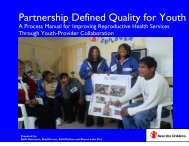

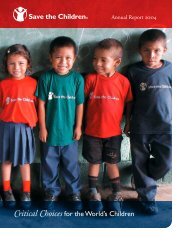
![View full document [PDF 3.39 MB] - PreventionWeb](https://img.yumpu.com/27308954/1/190x245/view-full-document-pdf-339-mb-preventionweb.jpg?quality=85)
